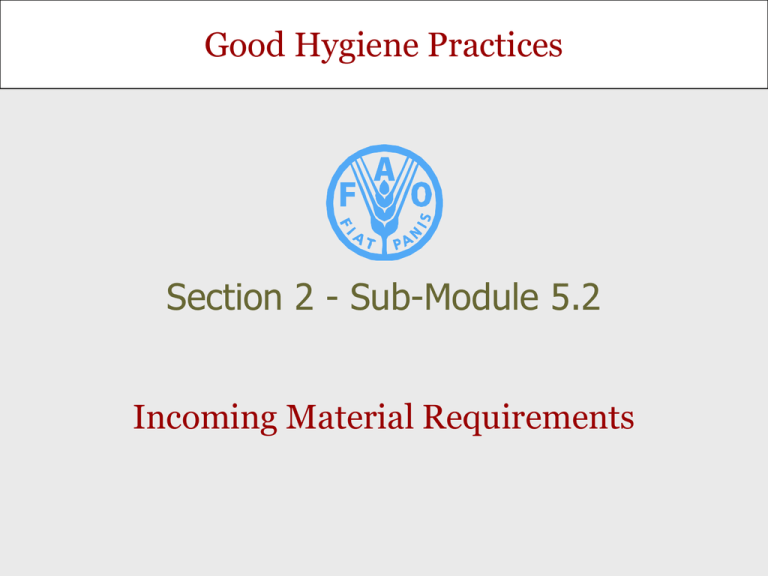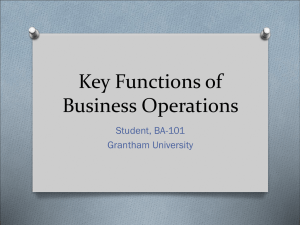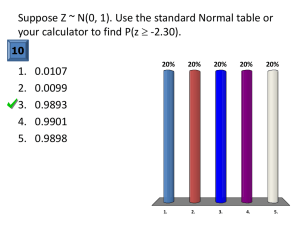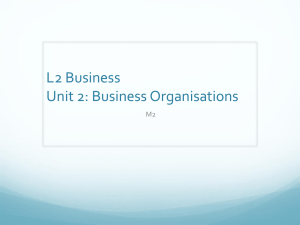Food Hygiene Issues in Primary Production - Sp
advertisement

Good Hygiene Practices Section 2 - Sub-Module 5.2 Incoming Material Requirements Incoming Material Requirements: Presentation Outline 1. Understanding the importance of incoming material control 2. Using Raw Material Specifications 3. Standardizing procedures to manage incoming materials 4. Demanding compliance with specifications 5. Choosing suppliers Slide 2 Module 5.2 - Incoming Material Requirements Raw materials influence the safety and suitability of foods Processing cannot remove all hazards Slide 3 Module 5.2 - Incoming Material Requirements The 3 key aspects of incoming material control Develop Slide 4 1. Raw material specifications 2. Standardized procedures of operation 3. Strong trading relationship with suppliers Module 5.2 - Incoming Material Requirements Incoming Material Requirements: Presentation Outline 1. Understanding the importance of incoming material control 2. Using Raw Material Specifications 3. Standardizing procedures to manage incoming materials 4. Demanding compliance with specifications 5. Choosing suppliers Slide 5 Module 5.2 - Incoming Material Requirements Why have raw material specifications? Purpose: Clear communication with suppliers Proof to authorities that existing standards are being followed Uniform internal system of supply management Slide 6 Module 5.2 - Incoming Material Requirements Raw Material Purchasing Specifications should focus on certain key elements SAFETY QUALITY Criteria related to Hazards Chemical Microbiological Physical Appearance Packaging Size Sensory characteristics Colour, taste and smell are important factors that influence the recipe Composition, critical ingredients Slide 7 Protein, fat, water, etc. Additives Module 5.2 - Incoming Material Requirements Base specifications on required and/or internationally recognized standards Consult sources such as Slide 8 Codex standards, national legislation, ISO standards, food industry norms. Module 5.2 - Incoming Material Requirements Additives must be food grade colorants antioxidants flavour enhancers Beware of carry-over ! Only use food-grade and permitted substances! Slide 9 Module 5.2 - Incoming Material Requirements Incoming Material Requirements: Presentation Outline 1. Understanding the importance of incoming material control 2. Using Raw Material Specifications 3. Standardizing procedures to manage incoming materials 4. Demanding compliance with specifications 5. Choosing suppliers Slide 10 Module 5.2 - Incoming Material Requirements Upon arrival all materials must be checked Conform and safe? Check all incoming materials upon receipt and react immediately if something is wrong. Slide 11 Module 5.2 - Incoming Material Requirements Develop precise instructions on how to receive materials in a standardized manner Develop a standard operating procedure (SOP) for receiving raw materials. Slide 12 Module 5.2 - Incoming Material Requirements Records prove that incoming materials have been checked Upon each receipt of materials one Standard Entry Form needs to be completed. Safety aspects Slide 13 Module 5.2 - Incoming Material Requirements Tag or mark all materials that have been checked Standard Entry Form Slide 14 Module 5.2 - Incoming Material Requirements Not all incoming materials will be 100% conform Materials of lower quality can still be used under certain conditions Non-conforming materials must be rejected. Slide 15 Module 5.2 - Incoming Material Requirements Grade incoming materials into a number of manageable categories Categories: • Accept • Accept under condition that extra treatment necessary • Reject Slide 16 Module 5.2 - Incoming Material Requirements Lower grade materials must be identifiable Standard Entry Form Clearly identifiable low-grade tag Slide 17 Module 5.2 - Incoming Material Requirements An example of a colour-coded form Slide 18 Module 5.2 - Incoming Material Requirements Keep documents personnel must consult to a minimum SOP Divide instructions between a basic SOP and Incoming Material Specifications specific for each material so document is easy to consult, and useful for instruction purposes. Slide 19 Module 5.2 - Incoming Material Requirements INCOMING MATERIAL SPECIFICATION INCOMING MATERIAL SPECIFICATION Grades Choose 2-3 people who will be responsible for checking incoming materials Train personnel to check incoming material. Give them the power and confidence to not accept material. Material must be checked immediately upon arrival. Slide 20 Module 5.2 - Incoming Material Requirements Overview of documentation of incoming materials The grading of all stored material must be visibly indicated. SOP INCOMING MATERIAL SPECIFICATION INCOMING MATERIAL SPECIFICATION Grades INCOMING MATERIAL SPECIFICATION Standard Entry Document Grades Store only labelled materials! Slide 21 Module 5.2 - Incoming Material Requirements Safe supplies require a steady level of communication Production department should inform quickly about low stocks; inform personnel if supplier has not met specifications communicate actively with QS; Buying department should foreseen potential lower quality of produce causes and communicate to inspecting personnel; QS-department should maintain good working relationships. Slide 22 Module 5.2 - Incoming Material Requirements Incoming Material Requirements: Presentation Outline 1. Understanding the importance of incoming material control 2. Using Raw Material Specifications 3. Standardizing procedures to manage incoming materials 4. Demanding compliance with specifications 5. Choosing suppliers Slide 23 Module 5.2 - Incoming Material Requirements The aim of testing is to assess whether a product conforms to specifications Tests should be: Rapid Simple Accurate Cost effective Slide 24 Module 5.2 - Incoming Material Requirements Key indicators that can be measured without the use of complex equipment Measuring indicators Sensory assessments Temperature Taste/flavour/odour Moisture content Texture pH Odour (grain) size Measuring devices must be regularly controlled for accuracy and precision! Slide 25 Module 5.2 - Incoming Material Requirements The value of visual inspections is often underestimated Trained personnel can spot the difference! Slide 26 Module 5.2 - Incoming Material Requirements Use visual inspections to check for physical contamination Carefully sift through materials by hand or use a special sieve. Slide 27 Module 5.2 - Incoming Material Requirements Record results of all performed checks Develop forms that are easy to complete Slide 28 Module 5.2 - Incoming Material Requirements Certain tests require complex equipment Testing for chemical contamination is not always practical. Slide 29 Module 5.2 - Incoming Material Requirements Complex test results often arrive after product has been sold Results of microbial tests are often only available after a certain number of days. Slide 30 Module 5.2 - Incoming Material Requirements Demanding additional guarantees from suppliers Demand written proof if criteria from supplier if: Slide 31 lack of equipment or expertise; no adequate laboratories available; regular analysis too costly; results only available after product has been consumed; no tests available for attributes such as “biological”, “halal”; Module 5.2 - Incoming Material Requirements Certificates of Analysis and Conformance Slide 32 Certificate of Analysis (CoA) Certificate of Conformance (CoC) Certifies the conformity of a batch of products to a specified test results. Confirms supplies conform to specific attributes i.e. free of additives. Module 5.2 - Incoming Material Requirements A Certificate of Analysis could look like this .. COMPANY NAME CERTIFICATE OF ANALYSIS Product: “Best Cocoa“ cocoa powder Analysis Colour Flavour fat content (%) pH fineness moisture content Standard plate count moulds per g yeasts per g enterbacteriaceae E. coli in 1 g Salmonella Result up to standard up to standard 12% 8.0 99.7 4.5% 400 <5 <5 negative negative negative Product Code: xxxxx Lot: 310676 Covering 300 bags of 25 kg Best Before date: 19/08/2010 Specifications up to standard up to standard 10-12% (extraction with petroleum ether) 7.8 – 8.2 99.5 min (wet through 200 mesh sieve) 5% max 5000 max 50 max 50 max negative negative negative (as per US FDA sampling method) We guarantee that our products are not sterilised by means of gas treatment or radiation. Signature: ........................................ (Laboratory Manager) Slide 33 Date: ............................. Module 5.2 - Incoming Material Requirements .. or like this (includes testing methods) “Best Sugar” Company LTD CERTIFICATE OF ANALYSIS CASTER SUGAR Appearance Flavour Aroma Allergens Shelf Life GM Status PARAMETER White Granulated Crystal Typical Absent Greater than 2 years Contains no GM ingredients, processing aids or additives during production Results of Analysis Cane sugar 99.93 % Reducing Sugar 0.004 Ash 0.01 Water 0.04 Colour 22 Turbidity 0 Insoluble Matter 0.03 Screen Analysis 2.7% (T 600 micron) Thermophilic Spore Count 18 Yeasts 1 Moulds <1 1 LIMIT TEST METHOD Min- 99.9% Max -0.04 % 0.02 % 0.04 % 50 Cl 5 Cl 5 ppm 4.0% Difference ICUMSA GS2/3-5 ICUMSA GS2/3-17 HMA Spectro Spectro filtration ICUMSA GS2/3-7 150 10 0 ICUMSA GS2/3-49 ICUMSA GS2/3-47 ICUMSA GS2/3-47 This information was obtained by laboratory analysis from source Batch ref #: 3098267 Slide 34 Module 5.2 - Incoming Material Requirements Be aware of fraudulent CoAs and CoCs Always control authenticity of certificates Slide 35 Module 5.2 - Incoming Material Requirements Incoming Material Requirements: Presentation Outline 1. Understanding the importance of incoming material control 2. Using Raw Material Specifications 3. Standardizing procedures to manage incoming materials 4. Demanding compliance with specifications 5. Choosing suppliers Slide 36 Module 5.2 - Incoming Material Requirements There are only limited possibilities of correction for non-conforming materials Sorting and processing cannot correct safety deficiencies of materials. Slide 37 Module 5.2 - Incoming Material Requirements Food businesses need trustworthy suppliers Identify and select supplies communicate specifications conduct on-site visits of supplies provide training enter long term trading relationship Slide 38 Module 5.2 - Incoming Material Requirements Supplier assessment Systems of supplier assessment (IT or manual) are useful tools to evaluate suppliers Trading safety for a better price is not an option! Inform suppliers once a year of how they have performed Slide 39 Module 5.2 - Incoming Material Requirements Incoming Material Requirements: Conclusions No raw materials/ingredients should be accepted by a food business if they represent a threat for food safety. Improve management of incoming materials by standardising controls using written SOPs, forms and by recording data. Personnel should be trained to check and grade incoming materials. Food business operators need trustworthy suppliers. Slide 40 Module 5.2 - Incoming Material Requirements YOU ARE HERE You have now completed Sub-Module 5.2 Incoming Material Requirements of Section 2 Applying GMPs after reviewing any supporting documents and links you desire, please proceed to Module 5.3 ... Slide 41 Module 5.2 - Incoming Material Requirements








